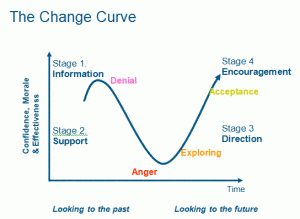It’s a fact of life – normally people don’t like change. They might grumble about what they’ve got but that’s nothing to the complaints you get when change starts to happen. I’m directing these comments to a change in Case, Practice or Document Management System, but the same goes for almost any area of business, or indeed life outside of work!
If you are the person charged with making the change happen, then the task can be daunting, wear you down and can leave you scarred. So here are a few tips from my own experience.
- Buy-in – If you are to lead this project or have a leadership role, then buy-in is essential. Start with yourself! You are the person you have the most control over and if you don’t believe in what you are doing then you will struggle. At the very least be at peace with the project. Otherwise you will be divided within yourself, that will cause you more heartache and be picked up by your staff. Ideally get buy-in and support from your line manager/senior staff above you. You’ll want to be able to focus on the team below you, without having to look over your shoulder. So ensure lines of responsibility and accountability are well defined. Where does the real decision making power sit? Are they onboard or does more work need to be done before you launch on the project?
- Vision – This needs to be clear – why is this being done, what is the business case, what has the decision-making process been, what is the aim, what is the route all are travelling to reach the goal. All of this should be thought through, documented and then revisited regularly, measuring what is happening against this. It will take a lot of the stress out of the situation, mean you have a defined program against which to make adjustments.
- Communication – This is just SO IMPORTANT and so often underdone. You may think that you have told people to the nth degree but they may well only have heard you once and then been in denial so it did not register. Communication of the vision, the process and the steps along the way will help you bring your staff with you and help them feel more secure during the change, so they are using up less energy worrying, which they can apply to their work and in making the changes required. Don’t forget that the communication needs to be 360°. So that means communicating with senior management. However, do not forget to create space for staff to communicate back with you – ensuring this is remains positive and progressing.
- Validation – Do not be defensive. It is very easy to be so, especially when you feel exposed. The feelings expressed to you will normally be genuinely felt. Validate the person speaking to you and then work though the concerns bearing in mind the vision and plans agreed and being implemented and what you aim to achieve. Presumably you want to get to the end with this person onboard, contributing positively to the success of the enterprise.
- Measure – Otherwise you are giving subjective opinions. Hopefully empirical data was gathered to guide the decision-making process before the project goals were set. Also, people tend to pay more attention to those things, processes, tasks they know are being measured. You can use this to embed key behaviours - but think through what you choose to measure. You do not want to be caught by the law of ‘unintended consequences’!
- Be Brave – The change may throw up evidence to show that procedures with which people are comfortable are now obsolete, less efficient or less fit for purpose than other ones now presenting themselves. This may challenge you as well as your staff. Keep in mind the vision and goal. Do not let them be derailed by one or two people. Do not fall into the trap of designing a project, process or business around a person who you do not have the courage to tackle. It will hopefully not be the case, but may happen that some hard discussions need to be taken if someone is not adapting or is running the risk of sabotaging the change. In the end, you are working to achieve a better performing business. You may be surprised, but your staff will respect you for taking the tough decisions.
- Be Positive – You have to be the projects greatest fan. But try to identify champions who can act as your lieutenants. You have to be resilient to carry the other people through with you. It would be wise if, before the project starts, you have identified where you can get moral support and have an impartial sounding post to use during the project.
- Change Curve – I find it useful to have a copy of this to mind if not to hand. Developed by people counselling the bereaved as documenting the path people travelled accommodating the loss of a loved one, the same stages are now widely accepted as being helpful in mapping the emotional journey travelled by people negotiating change. People may go through all the stages in a matter of seconds as a change is being explained to them, or it may take them months or years. Having an understanding of this can help greatly in bring your staff and your organisation through a change.

